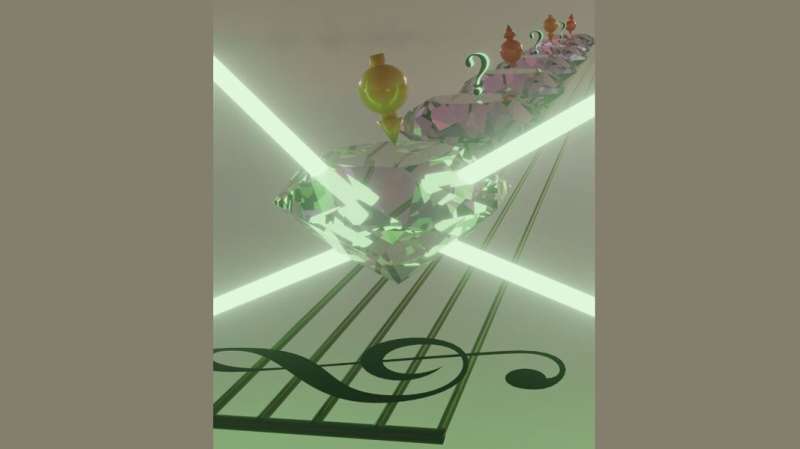
Researchers have made a groundbreaking observation of a new phase of matter known as the time rondeau crystal. This discovery, detailed in a study published on November 10, 2025, in Nature Physics, presents a unique interplay between long-range temporal order and short-time disorder. The term “rondeau” draws inspiration from a classical musical form characterized by repeating themes interspersed with variations, mirroring the crystal’s periodic behavior and its random fluctuations.
Leo Moon, a Ph.D. student in Applied Science and Technology at UC Berkeley, is a co-author of the study. He explained that the research stems from the intersection of order and variation in both art and nature. Moon noted, “Repetitive periodic patterns naturally arise in early art forms due to their simplicity, while more advanced music and poetry build intricate variations atop a monotonous background.” This concept is not limited to the arts; it also relates to natural phenomena, such as how ice forms a crystalline lattice while hydrogen atoms remain disordered.
The team’s investigation into the time rondeau crystal builds on recent advancements in the study of time crystals, which showcase long-lived periodic oscillations that defy the conventional understanding of temporal symmetry. Most previous research into non-periodic temporal order focused on deterministic patterns, like quasicrystals. The time rondeau crystal is distinctive in that it merges stroboscopic order with controllable random disorder.
Creating a New Phase of Matter
To create the rondeau crystal, researchers employed carbon-13 nuclear spins in diamond as their quantum simulator. This system consisted of randomly positioned nuclear spins at room temperature, which interacted through long-range dipole-dipole couplings. The team initiated the process by hyperpolarizing the carbon-13 spins, employing a technique that utilized nitrogen-vacancy (NV) centers—defects in the diamond lattice where a nitrogen atom is adjacent to an empty lattice site. When exposed to laser light, these NV centers become spin-polarized, allowing the polarization to transfer to the surrounding nuclear spins via microwave pulses.
The hyperpolarization process lasted approximately 60 seconds, increasing the nuclear spin polarization nearly 1,000-fold beyond its thermal equilibrium value. This enhanced polarization generated a robust signal that could be monitored over extended periods. Researchers then applied advanced microwave pulse sequences, integrating protective “spin-locking” pulses with precisely timed polarization-flipping pulses. This carefully structured yet partially random driving pattern yielded the rondeau order.
Moon highlighted the advantages of using diamond for this research, stating, “The diamond lattice with carbon-13 nuclear spins is an ideal setting for exploring these exotic temporal phases because it naturally combines stability, strong interactions, and easy readout.” Diamonds are chemically stable, insensitive to temperature changes, and adept at shielding spins from external noise.
The scientists implemented what they termed random multipolar drives (RMD). These structured sequences allowed for systematic control over the randomness within the system. During the drive cycle, the nuclear spins exhibited periodic behavior by flipping their polarization at regular intervals, while random fluctuations occurred between these measurements. This duality of predictable long-range order alongside random short-term variations defines the essence of rondeau order.
Observing Rondeau Order
The research team observed the rondeau order maintain its stability for over 170 periods, equivalent to more than four seconds. The dynamics were analyzed using a discrete Fourier transform, which revealed a critical signature of the new phase. Unlike traditional discrete time crystals that display a single peak in their frequency spectrum, the time rondeau crystal exhibited a smooth, continuous distribution across all frequencies. This characteristic serves as a “smoking gun” confirming the coexistence of temporal order and disorder.
Moon emphasized the significance of the findings, stating, “Rondeau order shows that order and disorder don’t have to be opposites—they can actually coexist in a stable, driven quantum system.” The researchers successfully controlled the system’s behavior by varying drive parameters, allowing them to create an extensive phase diagram of rondeau order stability. The lifetime of this order could be adjusted by manipulating the drive period and pulse imperfections, while heating rates followed predicted quadratic and linear scaling laws.
Additionally, the team demonstrated that information could be encoded within the temporal disorder. By engineering specific sequences of drive pulses, they encoded the title of the paper, “Experimental Observation of a Time Rondeau Crystal. Temporal Disorder in Spatiotemporal Order,” into the micromotion dynamics of the nuclear spins, storing more than 190 characters. This innovative approach illustrates that information storage can occur not in spatial configurations but in the temporal domain, represented by the spins’ orientations at particular moments.
While immediate applications remain speculative, Moon described the concept as fascinating. He noted, “The idea itself is fascinating that disorder in a non-periodic drive can actually store information while preserving long-time order.” This duality could have implications for developing quantum sensors tailored to specific frequency ranges.
The research expands the understanding of non-equilibrium temporal order beyond conventional time crystals. Using the same experimental framework, the team also explored related phenomena, successfully realizing time aperiodic crystals and time quasicrystals, including the Thue-Morse and Fibonacci sequences.
Looking to the future, Moon indicated that the team is investigating alternative material platforms beyond diamond, such as pentacene-doped molecular crystals, which feature hydrogen-1 nuclear spins for enhanced sensitivity. He concluded, “Harnessing the tunable disorder in such systems could pave the way for practical quantum sensors or memory devices that exploit stability in the temporal domain.”
This research opens new avenues in the study of quantum systems, providing a deeper insight into the complex interplay of order and disorder in the fabric of matter.






